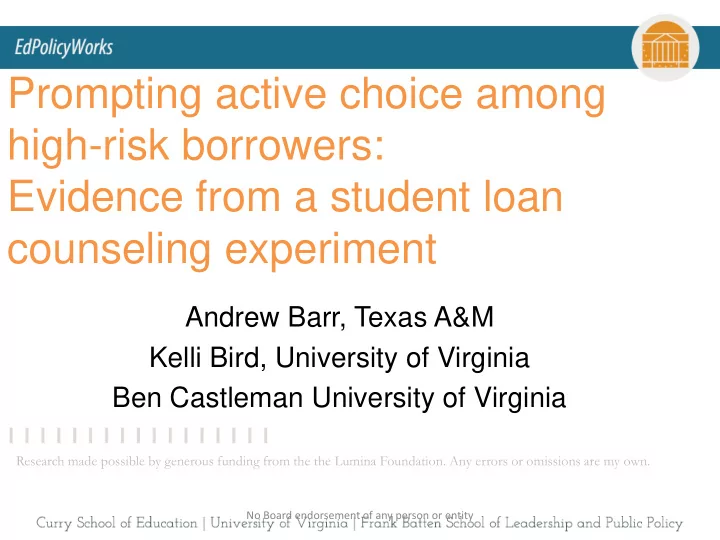

Prompting active choice among high-risk borrowers: Evidence from a student loan counseling experiment Andrew Barr, Texas A&M Kelli Bird, University of Virginia Ben Castleman University of Virginia Research made possible by generous funding from the the Lumina Foundation. Any errors or omissions are my own. No Board endorsement of any person or entity
Increasing role for behavioral science in public policy “A growing body of evidence demonstrates that behavioral science insights…can be used to design government policies to better serve the American people.” -President Obama Executive Order, directing federal agencies to incorporate behavioral science No Board endorsement of any person or entity
Interventions to promote active and informed decision-making Expand college choices (Hoxby & Turner, 2013) Increase financial aid eligibility (Bettinger et al., 2012) Complete required pre- matriculation tasks (Bettinger et al., 2012) No Board endorsement of any person or entity
Behavioral science and student loans (Dynarski, 2015) No Board endorsement of any person or entity
FACT SHEET: Department of Education Announces Efforts to Strengthen Loan Counseling (Aug. 2016) • Accurate and timely loan information can help students make informed decisions about borrowing • Limited rigorous research on how to make loan counseling more effective: • Types of content and delivery methods • When—and how often—counseling should occur • Test whether requiring additional loan [information and] counseling is effective in boosting academic outcomes No Board endorsement of any person or entity
Mixed evidence from concurrent loan interventions • Including loan offers in all financial aid packages: course drops, credits earned (Marx and Turner, 2016) • Sending flagship university students a letter with tailored info about cumulative borrowing and future repayments: borrowing/academics (Darolia, 2016) • Sending flagship students a letter with cumulative borrowing info and academic advice: borrowing, performance (Stoddard et al., 2016) No Board endorsement of any person or entity
Community College of Baltimore County student loan texting project 1 week from application to intervention 1 month of texts 8 texts over the course of the intervention 33 waves of applicants to date No Board endorsement of any person or entity
Reduce barriers to one-on-one loan counseling No Board endorsement of any person or entity
Prompt choice and simplify information No Board endorsement of any person or entity
Connect present borrowing to future expense No Board endorsement of any person or entity
Declines in unsubsidized Stafford borrowing * * Impacts concentrated among: (1) Fall ‘15 students, (2) Females, (3) students with low GPAs, and (4) Black students No Board endorsement of any person or entity
Shifts across distribution of borrowing No Board endorsement of any person or entity
Negative effects on academic outcomes * * Effects driven by: (1) Academically marginal students and (2) Students who received intervention prior to priority aid deadlines No Board endorsement of any person or entity
Mechanisms driving impacts • Borrowing impacts – Surveys indicate texts provided new info and helped connect students to counselors. Particularly salient for students w/ lower levels of fin lit? – Impacts larger when loans were auto-packaged vs. when students had to actively seek out loans • Academic impacts – No evidence from surveys of increased hours worked or financial stress – Prompted early withdrawal for academically struggling students? Acad. Impacts appear to fade. No Board endorsement of any person or entity
Policy implications • Many questions remain about the relationship between borrowing and academic/subsequent outcomes • Need to consider unintended consequences: – Student reactions to borrowing info – Financial stress affecting academic performance (Mullainathan and Shafir, 2013) – Institutional incentives around loan counseling No Board endorsement of any person or entity
Recommend
More recommend